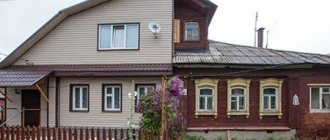Heated discussions on the issue of whether a balcony is part of the common property are due to the difference in apartment owners’ understanding of the concepts of “structural element” and “personal space”. They are trying to attach free access to all residents to the definition of “common property”. Differences in interpretations of current legislative norms were filed in the form of lawsuits in the courts, up to the Supreme Court. Thus, on January 17, 2012, the Appeal Commission of the Supreme Court of the Russian Federation issued ruling No. KAS11-789. Let's look at how shared ownership rights are distributed.
Legal grounds
The Housing Code of the Russian Federation (LC) states that the rules for maintaining common property in apartment buildings are established by the Government of the Russian Federation (Article 39). Such Rules were approved on August 13, 2006 (Resolution No. 491).
Subsection “B”, clause 2 of the Rules classifies balcony slabs that enclose load-bearing structures as part of the property belonging by right of common shared ownership to all owners of individual premises of an apartment building.
The rules and regulations for the technical operation of the housing stock (clause 4.2.4.2) assign balconies to load-bearing structures.
Article 36, Part 1 of the Housing Code establishes the classification of enclosing structures as common property.
Legislative acts do not provide for classifying only those elements that serve several premises as common property. Balcony floors are included in the overall integral design of each building as enclosing structures, providing stability and strength indicators.
Legislative aspects
A balcony is a platform that stands out from the plane of the facade. It is equipped with a fence and is used to sit on it during the warm season.
When determining the owner of the structure, the concepts of balcony and base slab should be distinguished. The slab refers to the load-bearing structures of a multi-storey, apartment building. This is indicated in the relevant Government Resolution. It belongs to common property. In this case, maintaining proper technical condition and updating the balcony slab should be carried out not by the owner of the apartment, but by the management company.
Balcony slabs have signs of common property according to the norms of the Housing Code (Housing Code). They participate in maintaining the strength and stability of the building and are considered enclosing structures.
Decision of the RF Armed Forces
The determination No. KAS11-789 of the appeal commission states that classifying the structural elements of the balcony of a separate apartment as common property does not in any way contradict the Housing or Civil Code. The Supreme Court of the Russian Federation recognized the balcony (loggia) slab as not intended for use in more than one apartment, but as belonging to the property for the common possession of the residents of the building.
Is a balcony or loggia a common property of the house?
Heated discussions on the issue of whether a balcony is part of the common property are due to the difference in apartment owners’ understanding of the concepts of “structural element” and “personal space”. They are trying to attach free access to all residents to the definition of “common property”. Differences in interpretations of current legislative norms were filed in the form of lawsuits in the courts, up to the Supreme Court. Thus, on January 17, 2012, the Appeal Commission of the Supreme Court of the Russian Federation issued ruling No. KAS11-789. Let's look at how shared ownership rights are distributed.
Distribution of Responsibility
Common property includes: slab, external fencing, external walls.
Owners of privatized apartments are divided into two camps according to their attitude to the need to repair the balcony:
- Part of your apartment (summer area). When buying a home, this is indicated in some contracts. Accordingly, they arrange their personal territory according to their wishes.
- Component of the facade of a house. Repairs are required to be carried out by the management company (MC) or housing department.
If we summarize all the regulatory documents together, we get the following distribution:
- Common property includes:
- plate;
- external fencing;
- external walls.
- Individual use:
- railings;
- window;
- doors;
- self-installed canopy, glazing, design solutions.
Therefore, responsibility for the maintenance of a specific element of this part of the living space may differ.
Additional approval is required for hanging flower boxes and other protruding objects that weigh down load-bearing parts on the outer part of the fence.
How to deal with the distribution of property
In multi-storey buildings, walls, floors, and ceilings separate the apartments; they are not divided between residents - this is shared ownership. To take into account “living space”, the area of residential and utility rooms, measured in m², is used. Such a space is equipped with finishing materials, filled with objects of use, and the ability of anyone to enter is limited. Actual ownership of an apartment, as a set of building materials, is just a legal term.
This is how the right to use a balcony with an exit from a privately owned premises is interpreted - the space indicated in the technical passport of the apartment for the tenant. Improving the situation by installing canopies, light frame structures for protection from bad weather and the sun, their repair, maintenance are included on the balance sheet of the apartment owner, will be part of his property. Some reconstruction options require approval from permitting authorities. The structural elements of the house belong to all participants in the housing association.
It is significant that the same relationships between residents arise when deciding on the placement of advertising structures and banners on the outer surface of the loggias. The general meeting of all owners decides by protocol the issue of consent to the placement of the poster. Moreover, the decision to remove unauthorized advertising products (by a resident, an outsider, a tenant) is also made by all homeowners.
Those parts of the house that are not divided by agreement of all participants according to some other criteria are divided into equal parts by everyone. If one owner has made a permanent improvement to his part, his share may be increased accordingly. The improvements being removed are the property of the resident.
It is for the operation of the building as a complex of technological systems that a mechanism of shared participation of all owners of individual apartments has been developed.
Who owns the balcony?
To answer this question, we should draw analogies with the ownership of residential premises - an apartment. Who is the owner of the apartment? After all, for example, the load-bearing wall of your apartment is also the wall of your neighbor’s apartment, and the floor slabs, which are your floor and ceiling, are both the ceiling and floor for the apartments of your neighbors living on the floor below and on the floor above. Thus, floor slabs and load-bearing walls are in common shared ownership, because they serve more than one room in the house.
It turns out that you are not the sole owner of either the load-bearing walls or the floor slabs that serve as the floor and ceiling of your apartment. What remains your property?
In fact, you are the owner of a three-dimensional space enclosed within the walls of an apartment, which, in fact, is a structural part of an apartment building. You are also the owner of the decorative elements and finishing of your living space - wallpaper, suspended ceilings, parquet, etc. Ownership of an apartment is a legal fiction designed to provide certainty for the population without immersion in complex matters and ease of understanding.
The situation is similar with balconies. The balcony slab is the common shared property of the apartment owners by virtue of the law. However, this does not mean that the interior space of the balcony with finishing elements is also common property.
If the house construction project provides for a balcony, access to which is, for example, from apartment No. 10 and this balcony is taken into account in the technical passport for the residential premises, then the three-dimensional space of this balcony belongs to the owner of apartment No. 10, while the balcony slab is the common shared property of all owners apartments at home.
It should be taken into account that canopies, awnings, and roofs on balconies installed (either without authorization or with the permission of a local government body) will not be the common shared property of all apartment owners in the building, just as the glazing of a balcony will not entail the emergence of common ownership of double-glazed windows and window frames. These “improvements” will be your property with all the ensuing consequences of bearing the burden of maintenance and responsibility for the consequences of causing damage to someone, due, for example, to snow falling from the canopy (canopy, roof) of your balcony.
Return to the table of contents of the practice review: How to legalize a built balcony, roof, balcony canopy, balcony glazing, loggias, combine a room with a balcony? Arbitrage practice
Repair of common household facilities
Maintenance and repair services, their volumes, quality requirements, regularity, are taken into account in the amount of fees for the maintenance of all premises, approved at the general meeting (if the property is managed by the management company), by the management of the HOA.
The commission inspection report is submitted to the HOA meeting for consideration. The meeting is authorized to make a decision on repairs with the consent of 2/3 of the votes of the total number of participants.
To make a competent decision on making repairs due to the emergency condition of the common property (balcony slabs, existing fencing), an application is sent to the director of the management company. One copy must be in the hands of the apartment owner - the applicant, in case of going to court due to refusal. Watch this video to see how the common household repairs are carried out:
The meeting of owners makes a decision on the need to allocate money for repairs at the request of the tenant, taking into account written proposals provided by the management company, on the expected start date of capital work, the required volume and types of work, the estimated cost of building materials, the schedule for the allocation of funds, and other essential conditions.
The owner of the apartment may be required to eliminate changes made to the shared part of the building if they violate established standards. In case of refusal to comply with the requirements, an appeal is sent to the State Housing Commission for inspection of violations.
Loggias and balconies. How to repair and what can be stored?
Apartments without balconies and loggias are an absurd mistake of architects and builders. A balcony is an architectural element that has not only a functional, but also a decorative purpose. For a city dweller, a balcony is a flower garden (possibly a mini-vegetable garden), a storage room (in a good way), a place for relaxation, and a kind of summer terrace. For many, this is their favorite place in the apartment. Today's selection of the portal contains information for those who want to equip balconies and loggias without violating the rules of residence, planning and without spoiling relations with neighbors.
BALCONY AND LOGGIA. WHAT IS THE DIFFERENCE?
The name “balcony” comes from the German word “balko”, which is translated as “beam” or “ledge”. The word "loggia" comes from the Italian "loggia", which translates as "room".
The Belarusian legislation (Resolution of the Council of Ministers dated March 24, 2015 No. 11 “On approval of the Instructions on the grounds for assignment and procedure for technical inventory of real estate...”) has the following interpretation:
balcony - a fenced outdoor area, half or more (of the area) protruding beyond the borders of the external walls of a permanent structure (building, structure) bordering it and open to the external space on at least two sides, or the upper or middle tier in the auditorium;
loggia - a covered and fenced outdoor area, more than half (of the area) enclosed within the adjacent external walls of the building and, at least on one side, open to the external space.
In other words, a balcony and a loggia are two different structures that differ from each other in location, design and fastening. The loggia is an integral part of the apartment (a built-in room limited on three sides by walls), and the balcony is a suspended extension protruding from the wall.
IS IT POSSIBLE TO INSULATE A BALCONY (LOGGIA) OUTSIDE?
Insulation of balconies and loggias from the outside refers to reconstruction work - installation of thermal insulation (clause 3 of the Regulations on the conditions and procedure for reconstruction and (or) redevelopment, approved by Resolution of the Council of Ministers of May 16, 2013 No. 384). This means that approval by the executive committee is necessary. To obtain a document on approval for reconstruction and redevelopment, you need to write an application and submit the following documents: passport, registration certificate for the apartment, plan diagram or list of works for reconstruction or redevelopment of the balcony (loggia), drawn up in any form.
But when carrying out repairs and insulation of balconies and loggias from the outside, you cannot change the general architectural and color scheme of the facade of a residential building (clause 4 of the Regulations). That is, if the house is gray with green balconies, you cannot paint your balcony with red paint.
DOES THE GLAZING OF BALCONIES AND LOGGIAS BE APPROVED BY THE EXECUTIVE COMMITTEE?
There is no need for approval in the sense of receiving a document. But it’s worth contacting the executive committee for information. The fact is that the glazing of balconies and loggias must be carried out taking into account the glazing options approved by the architect for a specific locality or street. This information (glazing options indicating color, materials and configuration) must also be posted on the official websites of local executive and administrative bodies.
Just keep in mind that we are talking exclusively about glazing. If, in addition to these works, it is necessary to replace the structural elements of the balcony (cladding, install overhanging decorative structures, etc.), which will increase the load on the balcony slab, then it will be necessary to develop design and estimate documentation confirming the load-bearing capacity of the structure. Well, if a residential building is included in the State List of Historical and Cultural Values of the Republic of Belarus, you will additionally need permission from the Ministry of Culture.
WHO REPAIRS BALCONIES AND LOGGIAS DURING A MAJOR REPAIR OF A HOUSE?
Major repairs are carried out according to a project developed for each specific house. Each building is first inspected, after which, during the design process, housing and communal services specialists determine a specific list of work (within the framework permitted by law) that will be carried out during the overhaul. In other words, if repairs to balconies and loggias are needed, it will be done using funds allocated for major repairs.
There is a standard contract for the provision of services for the overhaul of an apartment building, according to which the consumer has the right to restore the finishing in the residential premises that was damaged during the repair of enclosing structures and engineering systems of a residential building, as well as during the performance of other work, to the extent that was damaged during the work and due to violation of the temperature and humidity conditions of the building for reasons beyond the control of the residents (roof leakage, freezing of walls, etc.). But! Balconies and loggias will be repaired not based on the wishes of the home owner, but in accordance with the original design and estimate documentation for the house. In other words, if the original project had loggias with simply painted walls, then they will restore it that way. Anything additional that the homeowner has done, such as laying out decorative tiles, covering it with wood or plastic panels, or insulating it with slabs, will not be restored.
Before carrying out major repairs, the organization’s employees, as a rule, warn citizens about the need to remove the external and internal decoration of the loggia, if possible. If this is not possible or the housing and communal services organization did not warn residents about the need to remove the finishing, then you can demand restoration of the interior finishing of the loggia to the extent of the damage caused during the work as part of a major overhaul. Moreover, the restoration is at the expense of the organization that carried out the overhaul.
If the notification was sent but not received, then it is considered that the housing and communal services are not to blame for the violation of the finishing.
IS IT POSSIBLE TO MAKE A KITCHEN OR BATHROOM FROM A BALCONY?
It is impossible to convert a balcony or loggia into a heated room (for example, to combine it with a bedroom or kitchen, install a heated floor, move the stove, radiators, etc.). Redevelopment is, in principle, prohibited by law if it leads to a decrease in the load-bearing capacity of foundations, columns, walls, beams, floors, supports, roofs, and also entails disruption of the operation of smoke and gas removal systems.
If such redevelopment is discovered (for example, when taking meter readings, inspecting the apartment during routine inspections of gas stoves, re-registration or sale of the apartment, etc.), the owner of the property will be fined and obliged to return everything to its previous state - “as it was in the project.” And this is a waste of nerves and money. The only thing that can be done is to dismantle the wall between the living room and the balcony/loggia (if this does not lead to a decrease in the load-bearing capacity) and install, for example, glass doors between them.
IS IT POSSIBLE TO ATTACH A BALCONY TO THE APARTMENT IF IT WAS NOT PROVIDED IN THE PROJECT?
Theoretically, it is possible to add a balcony - this is work on the reconstruction of a residential building. In practice, it is very difficult and impractical. On forums where they share advice and tell how this happens in reality, the following joke is popular: “Do you want to add a balcony? No problem – buy an apartment with a balcony!”
Most often, owners of apartments on the first floor want to add a balcony. First of all, they need to contact the architecture and construction department of the local executive committee to find out whether such an extension is technically possible (there they can also discuss the issue of how to make the project, what approvals to go through - approx.).
Next, you will need the consent of 70% of the residents of the house - a joint household (a general meeting or a written survey is held). If the decision is positive, we go to the district administration with an application and documents (see subparagraph 9.3.2 of paragraph 9.3 of the list of administrative procedures carried out by government agencies and other organizations upon applications from citizens, approved by Decree No. 200).
If permission to reconstruct a residential building has been received, it is necessary to find a designer and prepare a project. Next, the project must undergo state examination. Then we register the upcoming construction with the state construction supervision (we draw up land management documents and the land plot). Next, you need to find a certified contractor - reconstruction of premises in multi-apartment residential buildings is carried out only under construction contracts with legal entities or individual entrepreneurs who have the right to architectural, urban planning and construction activities. When specialists have built a balcony for you, it needs to be accepted into operation, which will be done by a special acceptance committee. If everything is OK, we contact the BTI to re-register the apartment - now it will have a new registration certificate. If all of the above didn’t stop you, go for it. But if you want to “do everything quickly and do it yourself,” then for unauthorized addition of a balcony (or in violation of the design) you will receive an administrative penalty - a fine of 30 to 50 basic units, as well as a requirement to dismantle everything added.
WHAT TO DO IF THE BALCONY IS EMERGENCY?
As a rule, specialists from the building maintenance organization carry out inspections of balconies twice a year during scheduled spring and autumn inspections of the housing stock. If, during such an inspection, specialists discover that the structure is in disrepair, the balcony will be fenced off, the exit to it will be sealed, and residents will be given an order prohibiting the use of the balcony. Its repair is included in the work plan for the near future (scheduled repairs are carried out during the year at the expense of the service organization using funds allocated for routine repairs; the emergency situation of the housing and communal services must be eliminated within 24 hours).
But the residents themselves must monitor the condition of their balconies. If citizens discover cracks or other problems, they must immediately call a housing and communal services representative.
WHAT SHOULD NOT BE STORE ON THE BALCONY?
The reliability of balconies and loggias varies. If all requirements and operating rules are met, a balcony is a relatively safe structure. But, if this room is used as a storage for bulky and heavy things, over time it will begin to collapse.
The loggia is a completely safe room. Its base is a slab, which rests on supporting structures on almost all sides. Thanks to this, the main load is distributed evenly across the capital elements of the building.
Meanwhile, the Rules for the Use of Residential Premises (Government Decree No. 399 of May 21, 2013) prohibit the following on balconies and loggias:
- place heavy items such as furniture, televisions and refrigerators;
- store flammable substances, combustible materials and liquids;
- reduce the standard height of the fence, which is at least 1.1 meters from the floor, by increasing the thickness of the floor;
- change the shape and design of premises;
- unauthorized installation of canopies and devices for drying clothes outside balconies and loggias.
Some rules for the use of residential premises also apply to balconies and loggias. This applies to keeping pets and noise. For example, neither you nor your pets can make noise from 11 pm to 7 am, you can’t throw away cigarette butts (fire safety standards) and create unsanitary conditions (sanitary norms and rules). By the way, although smoking on the balcony is not prohibited by law, you should not do it if the smoke causes inconvenience to your neighbors - you live, as they say, under the same roof, why spoil the relationship, right?
Yana Shchuka, portal of communal literacy of the population
Accounting changes
A loggia or balcony, as a rule, is included in the total area and is paid with decreasing factors. If the owner carries out a renovation and combines it with an adjacent room, then this area becomes heated with corresponding heat charges.
In practice, management companies often do not include areas such as balconies in the list of property of the house when concluding a contract. Additionally, they confirm the obligation of the apartment owner to maintain their part of the property by sending out and delivering notifications about clearing snow from structures in winter. Taking into account such circumstances, the court takes the side of the company.
A separate point will be the ownership of one room in a separate apartment. In this case, the owner does not have the right to restrict the use of the balcony by all residents of the apartment or to separate it from the common part.
Cases in which glazing is prohibited (according to the European Legal Service)
If the glazing violates fire safety rules. For example, it is prohibited to glaze a balcony that leads to a fire escape - this design is typical for houses built in the 1970s-1980s.
It is prohibited to glaze balconies if this violates the appearance of buildings that are architectural monuments or of historical value.
You cannot glaze the balconies of dilapidated houses, since in this case there is a high risk of destruction of the load-bearing slabs.
According to the law, glazing of loggias and balconies is not directly related to redevelopment, but is equated to it, since it is necessary that glazing, like every change in living or common area, comply with fire, sanitary, hygiene standards, operational safety requirements and others. It is also necessary to take into account that glazing not only changes the architectural appearance of the building, but also, due to the weight of finishing materials and glass, increases the load on the floor slabs and facade finishing.










